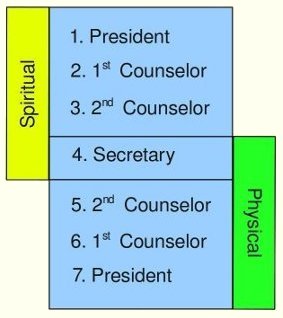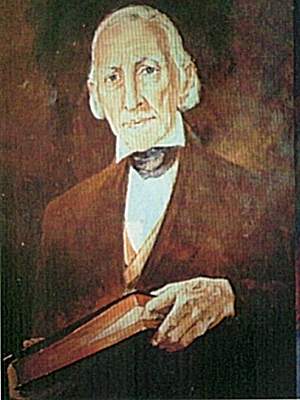
by John P. Pratt (31 March 2011)
©2011 by John P. Pratt. All rights Reserved.
| 1. Pattern of Seven |
| 2. Seven Angels |
| 3. Seventh Member |
| 4. Patriarchal Priesthood |
| 5. Conclusion |
| Notes |
The Lord's restored church was born on Tue 6 Apr 1830. At the time of its founding it had six members, and more were baptized that same day after the organizational meeting. The first person baptized that day, when added to the ordered list of the original six, fits a very interesting pattern. Let us consider what has been proposed to be the Pattern of the Seven which applies to the chief angels of the Lord. It is apparently a priesthood pattern. The manner in which the first seven members of the Church fit that pattern is discussed, along with the Melchizedek and Patriarchal Priesthoods.
 |
These seven work together as a team, just like the spiritual and physical parts of any living being.[2] The two presidents are not quite equal in authority because there is always one who must preside over all. In this pattern, it is the last who is first. That is, it is #7 which presides over the other 6. This part of the pattern is included in the scriptures. There is a priesthood Quorum of Seventy, and it has seven presidents. It is explicitly stated that the seventh presides over the other six (D&C 107:94). Thus, this pattern appears to be a priesthood pattern.
| Position | Angel |
|---|---|
| 1. President | Peter |
| 2. First Counselor | Moses |
| 3. Second Counselor | Abel |
| 4. Scribe | Enoch |
| 5. Second Counselor | Joseph Smith |
| 6. First Counselor | Noah |
| 7. President | Adam |
Then, counting upward from the bottom, the pattern is that it should form a presidency over the physical. Here we see Adam is in the President's slot, #7. Following the order of the pattern, Adam presides over not only the bottom four, but over all the other six, as is explicitly stated in scripture (D&C 88:112). Adam is the President of the Family of the Earth. Note that one of his main roles is that of being Father Adam, that is, he is the Patriarch of the entire human family. This seems to be part of the reason he is the president of the "physical" half of team. He is physically the father of all. He has a first counselor over the eastern hemisphere (Noah) and a second counselor over the Western Hemisphere (Joseph Smith). Enoch is his scribe (D&C 107:56-57). Now let us look at how the first seven members of the Church fit this pattern.
Now let us look at how these first seven members of the church seem to fit the same pattern as the seven chief angels of God. They are listed in the order of their baptisms. The only exception is that Joseph Smith, Jr., is listed at the top, even though he baptized Oliver Cowdery first, because the Lord designated him as the "First Elder" of the Church (D&C 20:2).
| Name | Position | Angel |
|---|---|---|
| 1. Joseph Smith, Jr. | President | Peter |
| 2. Oliver Cowdery | Assistant President | Moses |
| 3. Samuel H. Smith | Witness | Abel |
| 4. Hyrum Smith | Asst. Pres. and Patriarch | Enoch |
| 5. David Whitmer | Witness | Joseph Smith |
| 6. Peter Whitmer, Jr. | Witness | Noah |
| 7. Joseph Smith, Sr. | Patriarch | Adam |
Look at the first column of this table of the first seven members and notice how it fits the same pattern very well.
Those first four on the list were cornerstone members present at the founding of the Church. They were all indeed key foundational stones of the "spiritual" structure of the Church. Joseph was the President of the Church and Oliver was the first Assistant President. Later Hyrum filled that position until his death. The first slot is for the President of the Church, who is also the President of the High Priesthood. The High Priesthood, also called the Melchizedek Priesthood, is the "spiritual" priesthood of the Church. That is the priesthood that Peter, along with his counselors James and John, restored to Joseph Smith and Oliver Cowdery, giving them the authority of an apostle and the keys to organize the Church. Thus, it appears that the top slots are closely related to the Melchizedek Priesthood and the governing of the Church.
Before looking at the bottom four, you need to know that Joseph Smith, Sr., the father of the Prophet, was called by the Lord to be the first Presiding Patriarch to his Church. The Patriarchal Priesthood is discussed somewhat below, but the principal point here is that it is the same priesthood headed up by Adam, which was also the priesthood of the Old Testament "Patriarchs" such as Abraham, Isaac and Jacob. In a sense it is a "physical" priesthood because it is handed down from father to son according to the physical family lineage of the priesthood holders.
Now look at the bottom four of the seven, considering Joseph Smith, Sr., as presiding over the "physical" Patriarchal Priesthood. Note that Father Smith is in the same slot as Father Adam. Both head the Patriarchal Priesthoods. Moreover, Adam was the first man in the newborn world and Joseph Smith, Sr., was the first member baptized after the birth of the newly born Church.
As currently understood, a Patriarch has no counselors,[4] so David and Peter are apparently only filling slots in this comparison. The key point is that, at his death, Hyrum in the fourth position was both an Assistant President to President Joseph Smith Sr., and he was also the second Presiding Patriarch of the Church, succeeding his father. So position #4 is indeed shared between both the Presidency of the Church presided over by Joseph Smith, Jr., and the Patriarchal Priesthood presided over by Joseph Smith, Sr. It is this sharing of the fourth position that is the trademark of the Pattern of Seven. It has been unique in Church history that one man held two such high offices as Hyrum Smith did. His calling to the double role in this priesthood pattern explains it.
This pattern of the first seven Church members matching so well the pattern of the seven chief angels is a witness both of the Lord's hand in inspiring even the order of the first baptisms, and also of the importance of the Patriarchal Priesthood and its interaction with the Melchizedek Priesthood.[5]
 |
| Name | Date | Baptized by |
|---|---|---|
| 1. Joseph Smith, Jr. | 15 May 1829 | Oliver |
| 2. Oliver Cowdery | 15 May 1829 | Joseph |
| 3. Samuel H. Smith | 25 May 1829 | Oliver |
| 4. Hyrum Smith | June 1829 | Joseph |
| 5. David Whitmer | June 1829 | Joseph |
| 6. Peter Whitmer, Jr. | June 1829 | Oliver |
| 7. Joseph Smith, Sr. | 6 Apr 1830 | Oliver |
| 8. Martin Harris | 6 Apr 1830 | Oliver |
| 9. Lucy Mack Smith | 8 Apr 1830 | Joseph |
| 10. Sarah Witt Rockwell | 8 Apr 1830 | Joseph |
| 11. Hiram Page | 11 Apr 1830 | Oliver |
| 12. Catherine Whitmer Page | 11 Apr 1830 | Oliver |
| 13. Christian Whitmer | 11 Apr 1830 | Oliver |
| 14. Anne Schott Whitmer | 11 Apr 1830 | Oliver |
| 15. Jacob Whitmer | 11 Apr 1830 | Oliver |
| 16. Elizabeth Schott Whitmer | 11 Apr 1830 | Oliver |
| 17. John Whitmer? | 11 Apr 1830? | Oliver |
| 18. Solomon Chamberlain? | 12 Apr 1830? | Joseph |
| 19. Peter Whitmer, Sr. | 18 Apr 1830 | Oliver |
| 20. Mary Musselman Whitmer | 18 Apr 1830 | Oliver |
| 21. William Jolly | 18 Apr 1830 | Oliver |
| 22. Elizabeth Jolly | 18 Apr 1830 | Oliver |
| 23. Vincent Jolly | 18 Apr 1830 | Oliver |
| 24. Richard (Ziba) Peterson | 18 Apr 1830 | Oliver |
| 25. Elizabeth Ann Whitmer | 18 Apr 1830 | Oliver |
| 26. ? | ? | ? |
| 27. Newell Knight | May 1830 | David |
| 28. John Poorman | 9 Jun 1830 | David |
| 29. John Jolly | 9 Jun 1830 | David |
| 30. Julia Anne Jolly | 9 Jun 1830 | David |
| 31. Harriett Jolly | 9 Jun 1830 | David |
| 32. Jerusha Barden Smith | 9 Jun 1830 | David |
| 33. Katherine Smith | 9 Jun 1830 | David |
| 34. William B. Smith | 9 Jun 1830 | David |
| 35. Don Carlos Smith | 9 Jun 1830 | David |
| 36. Porter Rockwell | 9 Jun 1830 | David |
| 37. Caroline Rockwell | 9 Jun 1830 | David |
| 38. Electa Rockwell | 9 Jun 1830 | David |